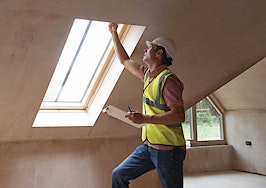- Real estate agents should be aware of radon issues because one in 15 homes in the U.S. and Canada have elevated radon levels.
- Radon can get into a home in many different ways, so every home should have a radon test every two years.
- Radon is the second leading cause of lung cancer.
Radon was the fifth radioactive element to be discovered and is the second leading cause of lung cancer, which is a shocking fact among many. It is the No. 1 cause among non-smokers, according to the Environmental Protection Agency.
In the United States, the EPA estimates that about 21,000 lung cancer deaths each year are radon-related, and in Canada that number stands at approximately 3,000.
Nearly one out of every 15 homes in the U.S. and Canada is estimated to have an elevated radon level. This is why it is great to be knowledgeable about radon and the effects it can cause to your clients.
As a real estate agent, you should know that radon is a dangerous gas; it is colorless, odorless, tasteless and radioactive. It is formed by the breakdown of uranium, a naturally radioactive material found in soil, rock and groundwater.
As radon decays, it produces new radioactive elements called radon daughters or decay products. Unlike the gaseous radon itself, radon daughters are solids that stick to surfaces, such as dust particles.
If such contaminated dust is inhaled, these particles can stick to the airways of the lungs and increase the risk of developing lung cancer.
How radon infiltrates a home
Radon mostly enters a building directly from the soil through the lowest level in the building that is in contact with the ground. High levels of radon in the water supply can also increase indoor radon air levels.
It typically moves up through the ground to the air above and into the home through cracks and other holes in the foundation. The home traps radon inside, where it can build up. Any home might have a radon problem — this means new and old homes, well-sealed and drafty homes, and homes with or without basements because this secret killer comes from the ground, not from construction materials.
There are many different ways radon can get into a home. Cracks in the floorboards or walls, gaps between suspended floors or service pipes are the most common.
Other ways radon can penetrate the home is through the water supply, construction joints or cavities inside the walls. The greatest risks for radon exposure come from buildings that are airtight, insufficiently ventilated or have foundation leaks that allow air from the soil into basements or first-floor rooms.
The concentration in one room of a building might be significantly different from the concentration in an adjoining room.
Testing for radon
Radon testing is the only way to know if your clients are at risk from radon. Every home should be tested at least every two years.
Testing takes approximately two to three days, results are provided and interpreted, and the report is sent directly to the client.
Recommendations will then be made for a mitigation system. Even owners of condominiums, houses built on slabs and other situations need to check on the air quality and the presence of radon in living quarters.
On top of having a home checked for radon every two years, your clients can also follow these four principal ways of reducing the amount of radon in their home.
Here are a couple of things you can tell your clients to do:
- Install sub-slab depressurization, which increases under-floor ventilation
- Improve the overall ventilation of the house by avoiding the transport of radon from the basement or ground floor into living rooms
- Install a radon sump system in the basement or ground floor
- Install a positive pressurization or positive supply ventilation system
Please visit www.pillartopost.com/radon for tools and resources, as well as how to contact your local home inspector.
Dan Steward is the president and CEO of Pillar To Post Home Inspectors You can follow him on Twitter or LinkedIn.







